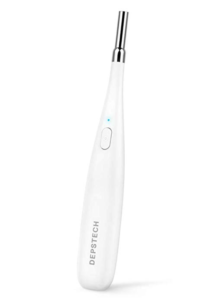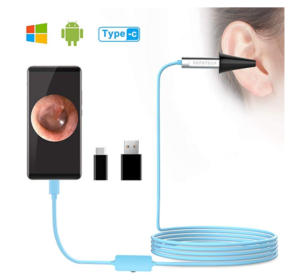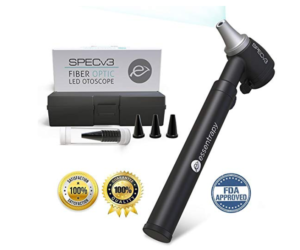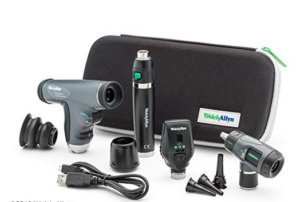Best Otoscopes in the Market, A detailed guide on what to consider when shopping for the best otoscopes in the Market.
5 Best Otoscopes
A table of the best otoscopes in the Market
| 1.DEPSTECH 3.9mm Upgrade Ear Otoscope
Features
2. ADC Otoscope, 2.5V, Soft Case, Proscope 5211
Features
3.DEPSTECH USB Otoscope, Digital Ear Scope Ear Inspection Camera Earwax Cleansing Tool
Features
4. SPECv3 Fiber Optic LED Ear Otoscope
Features
5. Welch Allyn Premium Diagnostic Set
Features
|
Getting to Know More About the Best Otoscopes
As we get to know more about the best otoscopes it is very important to get to know how the otoscopes are used.
Vibrating eardrums, weird pain, and itching in ears all need an examination of the ear..the three divisions of the human ear are the inner, middle, and outer year.
Otoscopy is a procedure that examines when a person experiences ear pain, discomfort, or giddiness ear pain for reasons not known. An otoscopy test is performed in cases where there is a blockage due to earwax, infection, or any other ear problems. Normally, this procedure includes the examination of the external ear with the help of an auriscope, which is also known as an otoscope.
This medical instrument is useful in determining the cause of pain in the ear. A speculum is placed at the front of the otoscope and is inserted the have a better look at the inner parts of the ear.
It greatly helps detect the reasons for the pain or discomfort faced by the patient. The otoscope instrument has a small air vent that helps the doctor in checking the balance and pressure in the ear
With advancing technologies, otoscopes have not been improved for better ear viewing. Video Otoscopes have been developed to see the live image from the ear canal on a live monitor. Other techniques also include checking the mobility of the tympanic membrane using an otoscope. This is accomplished by observing its response to pressure.
An otoscopy examination is rarely painful and very short. It takes a few minutes to perform. The instrument is pushed slowly into the ear to avoid hurting or disrupting the inner lining causing more harm.
The doctor has to be very careful to prevent any more harm. The ear is known to heal very quickly, but the wound can be a nightmare. Otoscopy is a diagnostic test and should be used for primary treatments like clearing wax or applying for medicine.
|
Best Electric Toothbrushes
|
Features of the Best Otoscopes
- The head
Regarding the head, there are four primary types of otoscope heads. The first general type is the diagnostic otoscope head, initially designed for traditional otoscopy, which provides magnification of the ear membrane. The magnification is not as high, but the lens can be replaced easily.
Next is the pneumatic otoscope head. This type was initially designed to provide magnification of the tympanic membrane and its movement. Its components include an eyepiece, an insufflator bulb used to introduce air into the ear allowing observation of the tympanic membrane movement. This otoscope also has a viewing lens.
Thirdly, the other type of otoscope head is the video otoscope head. These types of otoscopes do not come with an eyepiece. They have a cable that extends from the head of the otoscope. The other end usually comprises a USB cable or another standard connection that allows interface with the monitor or computer. This allows for the ear parts to be screened on a screen.
The head in this otoscope looks different from the rest of the otoscope heads. It has an open system design. A lot of space is left between the eyepiece and the tip of the head where a speculum is attached.
When the speculum is removed, the head otoscope can be used for other purposes other than magnification. This design does not limit in terms of instruments’ range of motion when inserted into the ear canal.
This otoscope, however, has the limitation of having a very small lens. The doctor will take some time before getting used to using it.
- Light at the end of the speculum
The light source of an otoscope comes as a bulb. Bulbs come in several forms including xenon bulbs, halogen bulbs, LED lights, and incandescent bulbs. It is important to understand how each of these bulbs works to appreciate the advantages.
Incandescent light bulbs. These bulbs are known to have a very short lifespan. This is because the heat causes the tungsten to evaporate over time, leaving the filament very thin. When the filament is thin, it snaps resulting in a burned-out bulb. Have a relatively short lifespan, and since the heating, the tungsten filament gradually causes the tungsten to have a design that makes the incandescent bulbs fade in terms of strength of illumination prior to completely burning out.
In halogen light bulbs, The bulb is filled with halogen gas like bromine or iodine. As the filament is heated, the halogen gas usually recycles the tungsten and takes it back to the filament.
This greatly extends battery life. These bulbs are made to last longer, and they have a small sheet of quartz that ensures the hot temperature does not interfere with functionality. This sheet makes sure the bulb is not as hot when touched as the incandescent bulb.
Unlike incandescent and halogen light sources bulbs, the xenon bulbs do not contain a tungsten filament. Instead, they generate light from an electrical discharge between two electrodes that are contained in a xenon gas environment. This bulb consists of fused quartz that is filed with xenon gas that contains tungsten metal electrodes on each side. The light is usually generated by the electrically energized gas that is formed and sustained between two electrodes. These bulbs last much longer as they do not rely on filaments to generate light
Lastly, we have a light-emitting diode or LED lights. Like xenon bulbs, these also do not contain filaments hence they also last very long. Because they have no filament, they do not get hot hence requiring less power to illuminate. They are the most efficient source of light.
Parameters in the different types of lighting.
They include color, illumination, and burn.
Illumination is how bright light is generated. The brighter the light, the better. Incandescent bulbs are not bright as the other three types of bulbs. LED technology is the newest technology in the market. Incandescent lights produce a dull white color; halogen bulbs produce a bluish-white color, xenon a very bright white color while the LED lights come in a variety of colors.
Most LED bulbs ate white in color, but they do not have the normal pure white color. They generate a whitish-blue color. Technologies have made this bulb have different colors too. Advancements in the near future should allow for interchanging of the color when the otoscope is in use in order to have a better view of the whole ear.
We also have to consider the burn. This is the amount of heat the bulb generates when it is on. Incandescent bulbs are usually very hot when being used. Halogen bulbs remain hot as they have the quartz sheet.
Xenon bulbs are however hotter than halogen bulbs even though they have the quartz enhancement. The LED burns cool at all times. Having something hotter means you are likely to experience a burn from the bulb any time when you are working. When considering burn, think of the amount of time you spend working and being a patient.
- Power source
In terms of power source, otoscopes are. As for battery otoscopes or hardwire otoscopes. Battery otoscopes use disposable or nondisposable batteries while wired to a socket at the wall. This type, however, has a non-portability limitation.
How to choose the best otoscopes in the Market
With the different brands in the market all at different prizes, getting an ideal otoscope may prove challenging. However, with the below guide you will get it easier to choose an otoscope depending on your needs. These are the best otoscopes in the Market Guide.
- Select a convenient size for you.
Otoscopes come in two different sizes, a standard otoscope, and a pocket otoscope. The smallest otoscopes are pen-sized that has a clip to hold them securely in your pocket.
They are lighter than the full-size models, and their construction is normally not as robust, making them have a shorter lifespan. Metal pocket clips will last longer than plastic clips. When choosing the perfect size for you, you should consider the environment where you will be using it and the types of patients you are likely to encounter.
Also, you should think about what size is best for you. The smaller ones can be convenient but very tricky for someone with big hands to use. The standard models might have all the features but can wear you down due to their weight.
- The color of the otoscope
This is the least important feature, but it is a decision you will need to make in the end when choosing to purchase. After all, this is a piece of medical equipment and how it performs is more important than the color or how it looks. However, manufacturers have still made this equipment in different colors giving the doctor an opportunity to express their personality even at work.
- Selecting a reusable or disposable specula
This is unlikely to influence your choice of otoscope as they can be used as either. They come in many sizes to suit all needs. Unlike reusable specula, disposables do not require complete decontamination after use because they are simply removed and binned.
Some models, however, include a specula ejection system, meaning there is no need to touch the contaminated item after use. Even though the specula are very similar, it is recommended that you use the appropriate brand for the manufacturer of your otoscope.
The benefits of fiber optics. Most advanced otoscopes now use fiber optics filaments which usually direct light from the filament or LED bulb that direct the light from the filament or LED bulb.
Hence allowing for light to be directed in the ear from a ring around the specula. There will be nothing to obstruct vision through the lens. This is because the bulb needs to sit inside the specula to be directed into the ear canal.
- The power source of the otoscope
There are three different options for powering the otoscope; disposal batteries normally AA size ones, rechargeable batteries and last ones that have to stay connected to power. Pocket-sized otoscopes usually use alkaline batteries. Some otoscopes have rechargeable batteries too.
Types of Otoscopes
The most commonly used otoscopes by audiologists are categorized into three groups, depending on the general design. The first type of otoscope is the pocket otoscope; the second type is referred to as a full-sized otoscope, and finally, we have the video otoscopes.
The otoscopes consist of a head and a handle. The head is made up of a simple low power magnifying lens, light source, and a few diopters. All otoscopes come with a disposable fitting or cover, so each patient is given a sanitary exam.
However, based on a variety of features, there are several types of otoscopes available other than the three general types. Most of the best otoscopes in the Market fall under these categories.
- Pocket otoscopes
Just like the name, this type was designed to be carried in the pocket of a lab coat. They are smaller and lightweight to enable portability. They have a clip on the handle to prevent them from dropping from the pocket.
Most pocket otoscopes use disposable batteries to power the light source. Usually, they require two AA alkaline batteries. Others, however, will come equipped with special handles that accept rechargeable batteries. The AA batteries are found in the handle. It is very easy to unscrew the head of the otoscope from the handle
Pocket otoscopes are not interchangeable hence limiting to certain parts. Hence, once you get one you will use that for a long time. In case you need to invest in newer technologies, you will have to get a new device.
- Video Otoscopes
The other type of otoscope is video otoscope. This type has a monitor as a screen for viewing. The image is transmitted from the otoscope to the monitor for viewing.
Video Otoscopes have the advantage of being able to project the tympanic membrane in a larger manner. This offers a much more detailed view of subtle structures. Unlike the other types of otoscopes, video otoscopes are made to capture images.
One of the benefits of these otoscopes is that ear integrity can be documented during the whole treatment process. This documentation can be used for educative purposes during other procedures. The patient can also view his or her ear and see the progress.
Full-sized otoscopes
These types of otoscopes have a head and a handle. Unlike the pocket otoscopes, both the head and the handle can be interchanged. This allows for the same handle to be used by different heads. This handle feature was developed by Welch Allen and gave otoscopes the name interlocking tool. With this otoscope, you can replace an original head with a previous one at ease.
The greatest advantage of full-sized otoscopes is the flexibility that full-size otoscopes offer, which allows for taking advantage of the new technology as it develops. Also, you can change the head when you feel the need to. This can arise when you change your preferences when you want to upgrade specific components are to invest in a new otoscope.
Also, this type of otoscope saves you a great deal of money. They are mostly powered by a rechargeable battery instead of disposable ones. They have the advantage of the ability to charge them even when being operated hence saving a lot of time.
With this type of otoscope, you can leave it to charge at your wall outlet at night and be ready for a new day without the thought of the battery dying during work. There are however two aspects of a full-size handle that has to be checked.
First, it is important to access the side of the handle that plugs into a standard wall bracket in order to recharge the battery. Also, it is essential to be able to access the side where the battery compartment is to be able to replace it.
- Battery operated otoscopes
The battery-powered otoscope provides great mobility for the user. With this added mobility, providers can visit patients in a variety of environments including schools, homes, and senior care facilities.
Using the device is simple for the trained professional. In order to adjust the light inside the ear, it has one dial. Increasing the magnification is also simple and necessary to zero in on specific areas of the ear.
It’s mandatory that before using this otoscope, the battery should be fully charged to ensure a complete exam for every patient. Moreover, weak light output can make it difficult to determine a proper diagnosis.
- Wall mounted otoscopes
Just as the name suggests, a mounted wall otoscope is fixed to the wall and powered by the AC power from the wall. Using AC makes it very reliable for hours of use.
- Close head wall mounted otoscope
This types of otoscope have a fixed closed head. This system is easier to use, has fewer attachments, and is stationary.
- Open head wall mounts otoscope
This provides any instrument or plug-in to get attached to it for some extra output while examining the ear of the patient. The open head otoscope allows more attachment to the handle.
Factors to Consider when Choosing Best Otoscopes
Other than the basic features that you look at when purchasing otoscopes, you should also consider the following;
- Cost
Pocket otoscopes are the most affordable in the market today. With prices from as little as $100, you can get yourself an otoscope. However, these otoscopes have a limited utility as they do not have interchangeable heads. Full-sized otoscopes can be purchased separately as the head and the handle to accommodate changing needs.
When purchasing an otoscope, consider how and when you will be using it. The most important variables are the type of otoscope head, the cost, and the functionality of the otoscope.
You should get the most practical otoscope that suits your needs. If you are on a budget, you can get a low-cost handle and a better head, and you will still have a fully functioning otoscope.
- Size
The two main size categories of otoscopes are the pocket-sized otoscopes and the full-sized otoscopes. The pocket otoscope was designed to be carried in the pocket making it very portable. It is smaller, lighter, and more convenient than a full-sized otoscope.
They are however easy to lose during work hence they come with a clip for attachment on the outside of the pocket. Most are not rechargeable and require AA batteries. Also, they do not offer interchangeability of the head.
The full-sized otoscopes, however, are larger and heavier. They are not portable and are made of durable materials. They are however very convenient as they are flexible and portable.
Conclusion
The market offers very many quality otoscopes at different prices that can fit any audiologist’s budget and skill. The most important features of the best otoscopes should be the function and the size of the otoscope.
It is important to also know the different technological factors. Also, consider where and when you will use your otoscope before purchase as this affects your daily routine.






